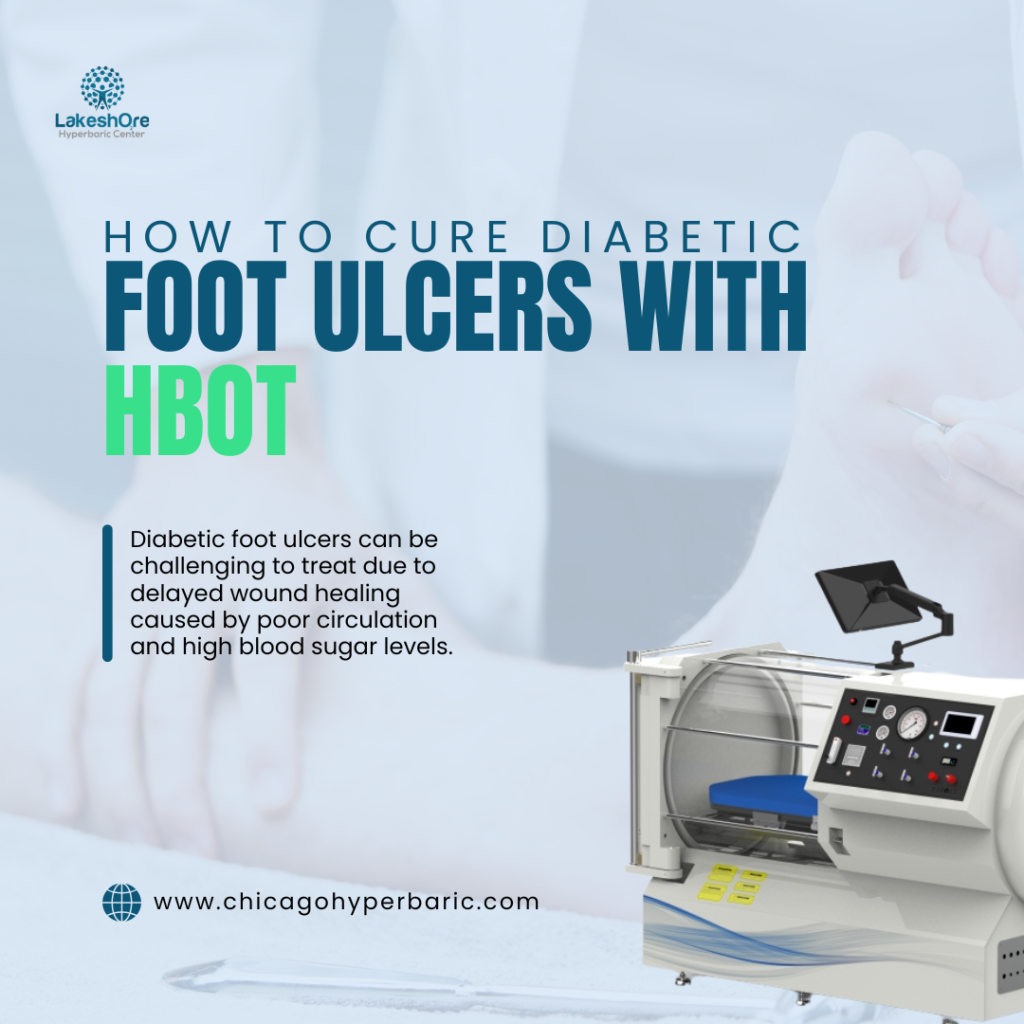Diabetic foot ulcers are a significant complication of diabetes, leading to prolonged suffering and, in severe cases, amputation. Understanding the causes and exploring effective treatments are crucial for promoting optimal wound healing. One advanced treatment option is Hyperbaric Oxygen Therapy (HBOT), which has shown promise in enhancing the healing process of these challenging wounds.
What Causes Diabetic Foot Ulcers?
Diabetic foot ulcers develop due to a combination of factors associated with diabetes:

- High Blood Sugar Levels: Elevated glucose levels can stiffen arteries and narrow blood vessels, restricting blood and oxygen delivery essential for tissue health and repair. cite turn 0search 0
- Poor Circulation: Diabetes increases the risk of peripheral arterial disease (PAD), which limits blood flow to the lower extremities, impeding the body’s natural healing abilities. cite turn 0search 0
- Nerve Damage (Diabetic Neuropathy): Chronic high blood sugar can cause nerve damage, leading to loss of sensation in the feet. This numbness means injuries may go unnoticed and untreated, increasing the risk of ulcers. cite turn 0search 0
- Immune System Issues: Diabetes can impair the immune system, reducing the body’s ability to fight infections and heal wounds effectively. cite turn 0search 0
Early recognition of these factors is vital in preventing the development and progression of diabetic foot ulcers.
The Science of Wound Healing
Wound healing is a complex biological process involving multiple stages that restore the integrity of damaged tissues. Understanding these stages is crucial to treating diabetic foot ulcers effectively.
Stages of Wound Healing
- Inflammatory Phase: This initial stage begins immediately after an injury and lasts for up to 72 hours. The body activates immune cells to fight infection, remove debris, and prepare the wound for tissue repair. In diabetic conditions, chronic inflammation may prolong this phase, slowing down recovery.
- Proliferative Phase: During this stage, which can last from a few days to several weeks, new tissue forms. Fibroblasts play a key role by producing collagen, which creates the structural foundation for angiogenesis (formation of new blood vessels). High blood sugar levels in diabetic patients can disrupt fibroblast activity, delaying tissue formation.
- Maturation/Remodelling Phase: This final phase, lasting weeks to months, involves the strengthening and remodelling of new tissue. In diabetes, prolonged exposure to high glucose can weaken collagen structures, making the wound more prone to reopening.
Diabetic conditions disrupt these critical stages, leaving wounds like foot ulcers susceptible to infection and delayed healing. Addressing these delays is essential to find effective solutions for how to cure diabetic foot ulcers.
Hyperbaric Oxygen Therapy (HBOT) in Wound Healing
Hyperbaric Oxygen Therapy (HBOT) has emerged as a groundbreaking treatment option for promoting wound healing, particularly in diabetic foot ulcers.
HBOT involves breathing 100% oxygen in a pressurised chamber. The increased atmospheric pressure allows oxygen to dissolve more efficiently into the blood plasma, delivering higher amounts of oxygen to tissues that are otherwise hypoxic (oxygen-deficient).
How HBOT Supports Wound Healing
- Enhanced Oxygen Delivery: By increasing oxygen levels in hypoxic tissues, HBOT creates a suitable environment for healing and counters the effects of poor circulation often seen in diabetic patients.
- Stimulates Angiogenesis and Fibroblast Activity: HBOT boosts the production of new blood vessels and activates fibroblasts to produce collagen, both of which are essential for the proliferative phase of healing.
- Reduces Infection Risk: HBOT generates oxygen free radicals that aid in killing bacteria, particularly anaerobic bacteria, while also enhancing the immune system’s ability to fight infections.
Several studies have shown that HBOT significantly improves the healing rates of diabetic foot ulcers by addressing the underlying issues that hinder recovery. Combining HBOT with standard wound care protocols can provide an effective solution for managing diabetic foot ulcers and enhancing the healing process.

How to Cure Diabetic Foot Ulcers with HBOT
Diabetic foot ulcers can be challenging to treat due to delayed wound healing caused by poor circulation and high blood sugar levels. Hyperbaric Oxygen Therapy (HBOT) has proven to be a valuable adjunct therapy for improving outcomes in such cases.
HBOT involves delivering 100% oxygen at high pressure to help increase oxygen levels in tissues with poor circulation. This therapy enhances wound healing by:
- Stimulating angiogenesis (the formation of new blood vessels).
- Promoting fibroblast activity and collagen production.
- Reducing the risk of infection by improving oxygen-dependent bacterial killing.
Combining HBOT with Other Treatment Modalities
- Proper Wound Care: HBOT works best alongside traditional wound care, including regular debridement (removal of dead tissue) and advanced dressings that maintain an optimal environment for healing.
- Glycaemic Control: Managing blood sugar levels is critical, as high glucose levels impair all stages of wound healing.
- Antibiotics: In cases where an infection is present, HBOT can complement antibiotic therapy by enhancing drug efficacy and improving oxygen availability in tissues.
Numerous clinical studies have shown that patients with diabetic foot ulcers who receive HBOT experience faster healing, reduced infection rates, and a lower risk of amputation. By addressing the root causes of diabetic foot ulcers and promoting all stages of wound healing, HBOT provides a comprehensive approach to how to cure diabetic foot ulcers.
Additional Tips for Managing Diabetic Foot Ulcers
Effective management of diabetic foot ulcers goes beyond medical treatments like HBOT and requires consistent care and preventive practices. Here are some essential tips:
- Daily Foot Care:
- Inspect your feet daily for signs of cuts, blisters, redness, or swelling.
- Keep your feet clean and dry to prevent infections.
- Moisturise dry skin but avoid applying lotion between the toes to reduce the risk of fungal infections.
- Wear Proper Footwear:
- Use well-fitted shoes with adequate cushioning and support to avoid pressure points.
- Avoid walking barefoot, even indoors, to prevent accidental injuries.
- Regular Check-Ups with Healthcare Providers:
- Schedule regular visits with a podiatrist or diabetes specialist to monitor foot health.
- Early intervention by a healthcare provider can address minor issues before they develop into ulcers.
- Maintain Healthy Blood Sugar Levels:
- Proper glycaemic control is essential for preventing and managing diabetic foot ulcers, as high blood sugar impairs wound healing and increases the risk of infection.
These steps, combined with advanced treatments like HBOT, can significantly improve outcomes and reduce the risk of complications.
Overview
Diabetic foot ulcers are a serious complication of diabetes, primarily caused by poor circulation, nerve damage, and high blood sugar levels. Understanding what causes diabetic foot ulcers and the stages of wound healing—namely the inflammatory, proliferative, and maturation phases—is crucial for effective management.
Hyperbaric Oxygen Therapy (HBOT) offers a cutting-edge solution to support wound healing. By enhancing oxygen delivery, stimulating new blood vessel growth, and reducing infection risk, HBOT plays a pivotal role in how to cure diabetic foot ulcers. When combined with daily foot care, proper glycaemic control, and regular medical oversight, HBOT significantly improves patient outcomes and quality of life.
If you or a loved one is struggling with diabetic foot ulcers, consider consulting specialists to explore personalised treatment options, including HBOT.
Contact Chicago Hyperbaric today to learn how HBOT can support your journey to recovery. Our experienced team is here to provide expert care tailored to your needs. Call us or visit our website to schedule your consultation and take the first step toward healing.
Read More:
How Mild Traumatic Brain Injury Leads to Postconcussion Syndrome and What You Can Do About It
HBOT for Alzheimer’s: A Promising Treatment for Cognitive Decline
IBD Management: Understanding the Therapeutic Effects of HBOT in IBD
Asthma Management with HBOT: A New Approach to Breathing Easier
Sudden Sensorineural Hearing Loss (SSNHL) and the Efficacy of Hyperbaric Oxygen Therapy
Using Hyperbaric Oxygen Therapy to Manage Multiple Sclerosis




